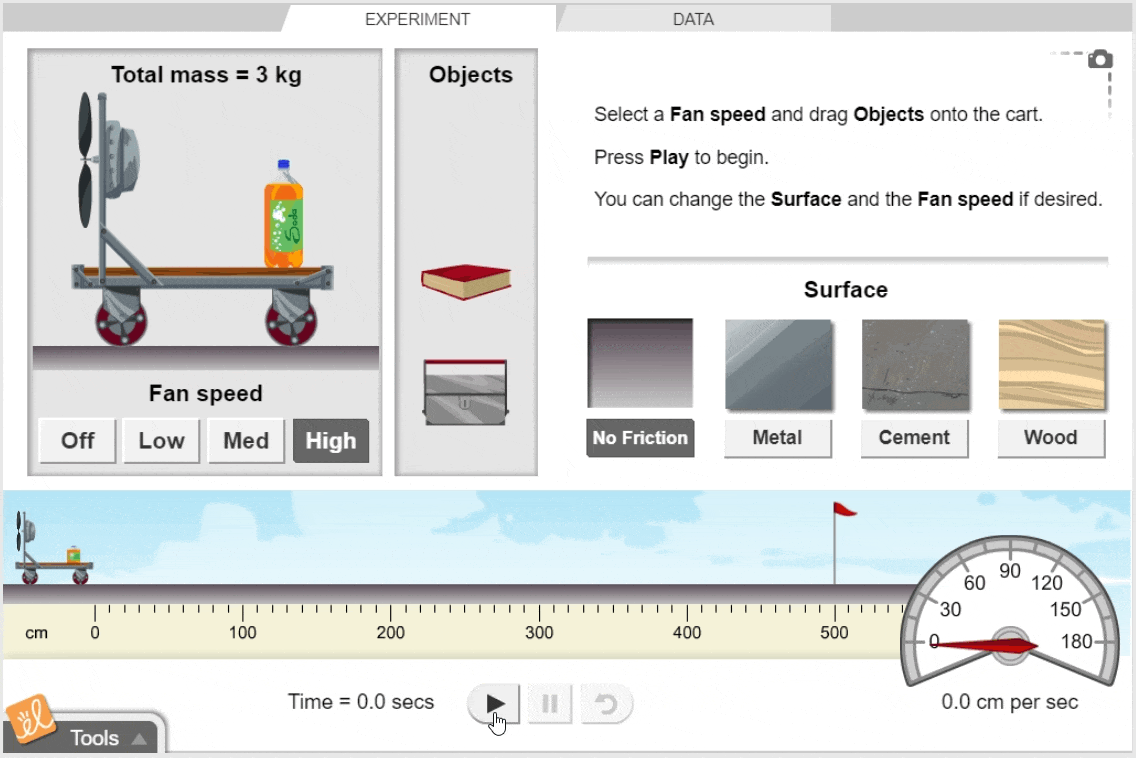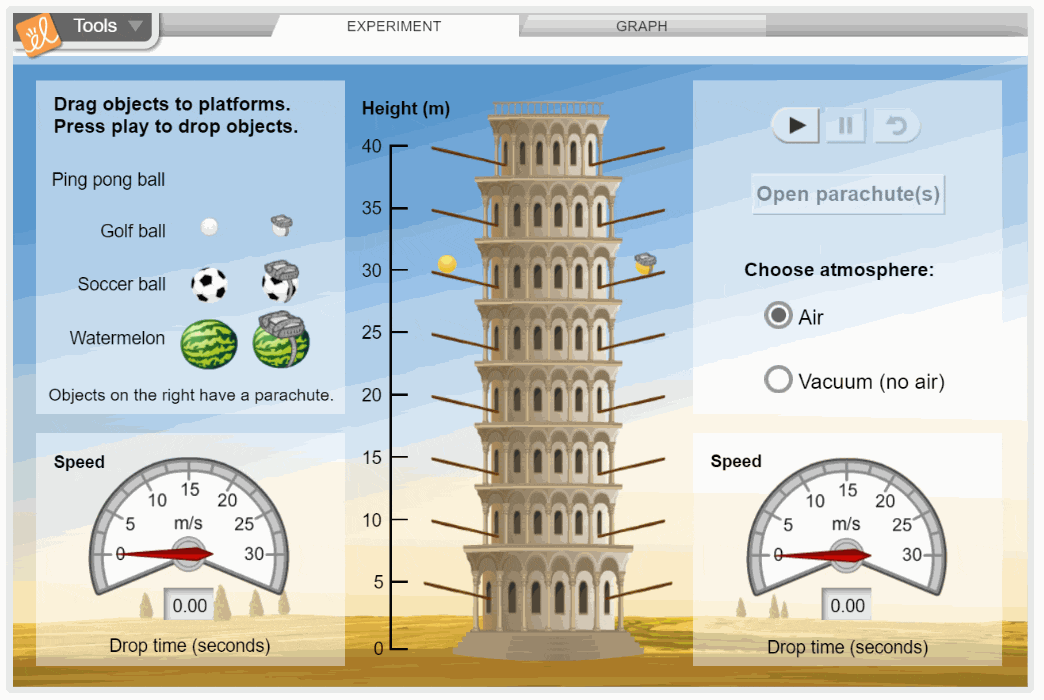Fun Ways to Teach Newton’s Laws of Motion to Students

Sir Isaac Newton was an English physicist, mathematician, and astronomer. In the 1600s, he observed some curious events leading to Newton’s Laws of Motion. Philosophers at the time had tried to figure out simple rules to define how things work in the universe, but those laws of motion finally explained what they had been searching for.
Today, these foundational principles are still taught in classrooms around the world. Teaching Newton’s theory of motion in a modern classroom goes beyond memorizing formulas; it’s about exploring how motion, force, and inertia shape the world we live in every day. Newton’s 3 laws of motion help students connect scientific theory to real-world phenomena, like why seatbelts are essential in cars or how rockets launch into space.
Try Gizmos free for 45 days!
For a limited time, get an extended 45-day trial of Gizmos. Use code 45GIZIN to unlock your access. Transform your classroom and unlock students’ STEM potential today!
How to teach Newton’s laws of motion to students
When students are first introduced to forces, motion, and inertia, the concepts are highly abstract. Some experiments may be too dangerous, expensive, or impractical to attempt in a classroom. Virtual tools let students safely explore scenarios like car crashes (to understand inertia) or zero-gravity environments (to study motion in space), from the safety of devices.
Simulations, like Gizmos, allow learners to see how Newton’s laws apply to real-world phenomena, like a ball rolling down a ramp or a rocket launching, making the concepts more concrete and easier to grasp.
Students in all grade levels will examine forces and motion in science classes as established by Next Generation Science Standards. ExploreLearning Gizmos help students learn vocabulary words like inertia, acceleration, velocity, and equilibrium. Using the simulations, students can predict whether objects will move and when they will stop. They analyze the causes and effects to answer why. Through all of these investigations, students explore examples of Newton’s laws of motion. What are Newton’s laws of motion?
Unlocking the basics: What are Newton’s laws of motion?
Sir Isaac Newton worked with mathematics and physics. According to legends, he developed the theories of gravitation and transformed science when he was just 23 years old after watching an apple fall. In 1687, he introduced his laws of motion in “Principia Mathematica Philosophiae Naturalis.”
Common student misconceptions about Newton’s Laws
Many students come into physics with intuitive (but incorrect) ideas about how the world works, which can lead to common misconceptions about Newton's 3 laws of motion. A frequent misunderstanding is that heavier objects fall faster than lighter ones. This seems logical based on everyday experiences, but it contradicts Newton’s understanding of gravity and acceleration.
Another widespread misconception is that if an object is moving, a force must still be acting on it. This conflicts with Newton’s first law, which states that an object in motion stays in motion unless acted upon by an unbalanced force, meaning motion doesn’t require a continuous push. Teachers can use interactive models and simulations, such as those found in Gizmos, to visually and experientially correct misunderstandings.
Newton’s first law of motion
Newton’s first law of motion is inertia. This law states that an object at rest will stay at rest unless acted upon by an unbalanced force. Similarly, an object in motion remains in motion at a constant speed unless an outside force causes it to change. Inertia is the tendency to remain unchanged. Think about the way a kite changes motion with the wind.
Newton’s second law of motion
Newton’s second law involves force. This is the law that gave the equation: Force = mass × acceleration (F=ma). What does the equation mean? The second law states that the acceleration of an object depends on the mass of the object and the amount of force applied. What are some examples? They’re everywhere! Kicking a soccer ball and pushing a stroller are just a couple.
Newton’s third law of motion
Newton's third law of motion is often quoted. For every action, there is an equal and opposite reaction. Force on one object exerts force on the second object, which exerts a force equal and opposite to the first. Bouncing a ball or snapping a rubber band illustrates this law.
Fun approaches and activities to teaching laws of motion
Students love to have fun while learning because it keeps them engaged and makes challenging concepts feel more approachable and memorable. When learning is interactive and enjoyable, it sparks curiosity and encourages deeper exploration of new ideas. Newton’s laws of motion activities are perfect for incorporating activities that engage the whole class with work that doesn’t feel like work!
Here are a few activities with Newton’s laws examples that deliver the concepts AND the fun!
- Paper and Rock is a twist on the Rock, Paper, Scissors game. For this version, begin with a prediction. Tell students they will drop a rock and a wadded-up piece of paper simultaneously. They fall at an equal rate because the acceleration is constant due to the force of gravity acting on them. Did your students predict correctly?
- Bowl and a Marble is great for showing Newton's first law. Students roll a marble down the side of a bowl and watch it roll back and forth until it rests at the bottom.
- Pendulum Painting is a creative way to demonstrate motion and gravity. All you need is a pendulum (or any kind of weight tied to a string), paper, and paint. Hang the pendulum from a fixed point with paper underneath. After dipping the weight in the paint, let it swing back and forth. It’s a win for both science and art projects!
- Tug-of-War is all about force, so this game seems perfect. Know your school and district’s policy about this activity before using it with your students. If it’s permissible, create teams of equal size and have students compete against each other in a tug-of-war. Use a rope and a large, open area.
- Jenga might already be in your supply of classroom games. Did you realize it’s an example of Newton’s first law? Take the game out of the storage closet during science class for a lesson your kids will want to do again and again.
- Paper Airplane Races are always fun for students. Get creative with the designs and see how far each plane flies. Discuss how other factors, like lift, drag, or thrust, might affect the flight.
- Roller Coaster Design Challenge allows students to design and test a model roller coaster that illustrates acceleration, gravity, and inertia using basic materials (paper towel rolls, marbles).
- Balloon Rocket Races are a fun and effective way to model action-reaction forces. Use a string, a straw, and a balloon to create a rocket that races across a line.
- Newton’s Laws Scavenger Hunt lets students search to find and photograph real-world examples of each law around the school or at home.
Ready to elevate your science lessons?
Gizmos Investigations are now available! These interactive, scaffolded science lessons combine Gizmo simulations with built-in student questioning and just-in-time feedback to support sensemaking practices. Designed to meet next-generation science standards, they help all students actively engage in the doing of science. Explore how Gizmos Investigations can transform your classroom today!
Teach Newton’s laws of motion with interactive virtual labs
Virtual labs are effective ways to explore Newton’s laws of motion. Let’s take a look at just a few Gizmos.
Force and Fan Cart Gizmo

With the Force and Fan Cart Gizmo, explore the laws of motion using a simple fan cart. Students can drag up to three objects onto the fan cart. The speed of the cart is displayed with a speedometer and recorded in a table and a graph.
Free Fall Tower Gizmo

Students recreate Galileo's famous experiment with the Free Fall Tower Gizmo by dropping objects, like ping pong balls, golf balls, soccer balls, or watermelons, off the Tower of Pisa. Objects can be dropped in or without air or a parachute.
Gravity Pitch Gizmo

Let your students throw balls on different planets with the Gravity Pitch Gizmo to see how each planet's gravity affects the ball. They will observe the ball's path when thrown at different velocities.
Feed the Monkey Gizmo

Ready for some fun with the Feed the Monkey Gizmo? Fire a banana cannon at a monkey in a tree. The monkey drops from the tree when the banana is fired from the cannon. Students determine where to aim the cannon so the monkey catches the banana.
Through inquiry-based learning, teachers can use simulations to guide students through prediction, observation, and reflection cycles. By encouraging students to test their assumptions and see real-time results, educators help them replace any misconceptions with scientifically accurate models. Pairing Gizmos with class discussions, hands-on experiments, and formative assessments ensures deeper understanding and long-term retention.
Bring Newton’s Laws to life with Gizmos today
With over 550 simulations and STEM Cases available, Gizmos makes it easier than ever to teach Newton’s laws of motion in fun, interactive, and NGSS-aligned ways. Sign up today for a free trial and see firsthand how Gizmos can energize your science lessons and empower your students.